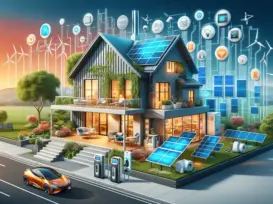Grus Home Energy - Sustainability in Home Energy
Embracing a Greener Future: Innovative Strategies for Sustainable Home Energy
Embracing a Greener Future: Innovative Strategies for Sustainable Home Energy
In the face of global climate challenges, sustainability in home energy is becoming an increasingly vital concern for homeowners around the world. It’s not just about reducing the environmental impact, but also about enhancing efficiency and saving on energy costs in the long term. Adopting sustainable energy solutions for our homes is a powerful step towards a greener future.
The concept of sustainability in home energy encompasses a variety of practices and technologies that contribute to a more efficient and environmentally friendly use of resources. One of the most significant aspects of sustainable home energy is the shift towards renewable energy sources like solar, wind, and geothermal power. Solar panels, for instance, have become more affordable and efficient, making them a practical option for residential energy production. Wind turbines are also viable in areas with consistent wind patterns, while geothermal systems use the earth’s stable temperature to heat and cool homes.
Another key element is energy efficiency, which involves reducing energy consumption through smarter design and technology. This includes the use of energy-efficient appliances, LED lighting, and smart home systems that monitor and manage energy use. Proper insulation and energy-efficient windows can significantly cut down on heating and cooling needs by maintaining a more consistent internal temperature.
Furthermore, the integration of home energy management systems (HEMS) plays a critical role in optimizing energy consumption. These systems can analyze energy usage patterns and make adjustments to improve efficiency. They can control lighting, appliances, heating, and cooling systems, shifting usage to off-peak times to take advantage of lower rates where variable pricing is available.
In addition to these technological advances, simple behavioral changes can also lead to substantial energy savings. Practices such as unplugging electronics when not in use, using natural light during the day, and being mindful of heating and cooling settings can make a big difference in a home’s energy footprint.
Water conservation is another aspect of sustainable home energy. Implementing low-flow fixtures, rainwater harvesting systems, and water-efficient landscaping can reduce the energy required for water heating and treatment. Plus, these practices contribute to the conservation of a vital resource and reduce the overall environmental impact of a home.
Finally, new construction and renovation projects present an opportunity to incorporate passive solar design principles. These include strategic placement of windows, thermal mass materials that store and slowly release heat, and landscaping that provides shade and wind protection. Such designs enhance the natural regulation of a home’s temperature, thus reducing the reliance on active heating and cooling systems.
In conclusion, sustainability in home energy is not a one-size-fits-all solution, but rather a collection of practices and technologies that can be tailored to individual homes and lifestyles. By embracing renewable energy sources, improving energy efficiency, and making conscious lifestyle choices, homeowners can significantly reduce their ecological footprint while also enjoying the financial benefits of reduced energy costs. As technology advances and awareness spreads, sustainable home energy is becoming an attainable goal for an increasing number of people, paving the way for a healthier planet for generations to come.
Blog, Smart Home Automation , February 17, 2024 , Electric Vehicle (EV) Charging, Energy Consumption Analysis, Energy Management, Energy Savings and Profit, Heat Pumps Optimization, Home Battery Storage, Renewable Energy Technologies, Smart Grid Technology, Smart Metering, Smart Metering Systems, Solar Panels Efficiency, Sustainability in Home Energy
©2025 All Rights Reserved. Grus IoT Co.,Ltd.
